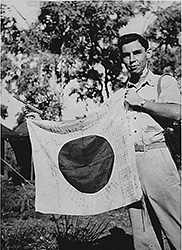

Other Sources for Military Service History |
In addition to Official Military Personnel Folders and pre-World War I pension and service files, the National Archives houses select card files, reports, correspondence, and subject files about American Indians' military service. Most of these records were created and maintained by the Bureau of Indian Affairs (BIA).
Card Files Relating to American Indians in World War I
These records provide information about individual American Indians who served in World War I, including their name, rank, and tribe. Sometimes, their age, military unit, drafted or enlisted status, camp where enlisted, and casualties suffered are also included.
In addition, cards for BIA agencies summarize how many American Indians within an agency's jurisdiction served and often what became of them after the war. Lists of Indian officers, Indian nurses, Indians receiving decorations, and Indians who were wounded or killed in action are also included.
These records are digitized and available in the National Archives Catalog. See National Archives Identifier 2124203 for a full archival records description and the digitized images.
Records Relating to American Indians in World Wars I and II
These records are arranged in three parts:
-
The first part contains a report on American Indian participation in World War II; articles on Navajo Code Talkers and American Indians at Iwo Jima; and lists of American Indians who were wounded in action, missing in action, prisoners of war, or decorated (all of which appear to be working drafts).
-
The second part is a general file on World War I, containing a report on "The Indian's War Activities," statistical sheets, a standardized form used to respond to inquiries, and listings of New York American Indians.
-
The third part, by far the largest, consists of standardized forms recording the participation of individual American Indians in World War I. The forms were used to compile the card files described above (National Archives Identifier 2124203).
Visit the National Archives Catalog for the full archival records description: National Archives Identifier 2123779.
These records have not yet been digitized. Contact the Archives 1 Reference Branch in Washington, DC, for access information.
Correspondence and Subject Files
Many BIA offices collected information about service members from tribes within their jurisdiction, for local publicity as well as to ensure the tribal members received due benefits from their service. These files include discussion of enlistments, the selective service, benefits, training, service statistics, decorations, and in some limited cases even photographs of servicemembers.
These files were organized within the BIA decimal code classification system under the 600 series, “Military Activities,” but are often unorganized beyond the general military topic. One such example is found within the Blackfeet Agency correspondence files (National Archives Identifier 7329400) at the National Archives at Denver.
In addition to the decimal files, there are also BIA subject files that include records pertaining to the military. For example, the Colorado River Agency’s subject files (National Archives Identifier 6212773) at the National Archives at Riverside include information about military draft registration.
Please note that records kept vary greatly from agency to agency. Contact the National Archives facility that holds BIA field office records for the tribe you are researching for information about available records. See Navigating Record Group 75 for help identifying the National Archives facility to contact.
Examples of Military Records from the BIA
- "Personal and Military Records, 1857–1863" (National Archives Identifier 649195)
Contact the National Archives at Fort Worth for more information - "Records Relating to Veterans, 1923–1929" (National Archives Identifier 656395)
Contact the National Archives at Fort Worth for more information. - "Draft Registration Cards, 1917–1918" (National Archives Identifier 4718529)
Contact the National Archives at Chicago for more information. - "Veterans Information Cards, 09/1946–09/1953" (National Archives Identifier 2184478)
Contact the National Archives at Kansas City for more information. - "Individual Veterans Training Folders, 1944–1952" (National Archives Identifier 279398)
Contact the National Archives at Atlanta for more information.
Documents that are less than 75 years old may contain personal information about individuals who are still living. These records may be restricted under Freedom of Information Act (FOIA) Exemption (b)(6), and must be screened by National Archives staff before being released to researchers. Personal information may be redacted. Learn more about FOIA.


